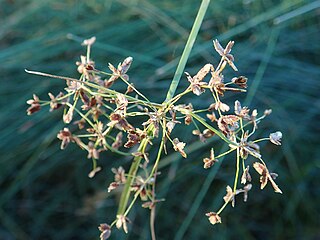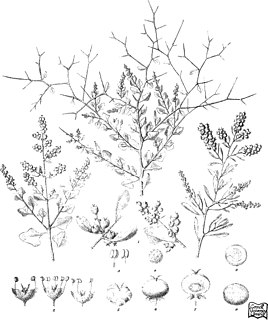
Velleia montana is a perennial herbaceous plant that is native to New South Wales, Victoria, and Tasmania in Australia, growing mainly in woodland and sub-alpine grasslands, and at higher altitudes south from Boonoo Boonoo. It has oblanceolate to obovate leaves that are 1.5 to 8 cm long and 6 to 30 mm wide. The yellow flowers have a 7 to 10 mm corolla. It blooms from November to February. The Latin specific epithet montana refers to mountains or coming from mountains.

Lambertia inermis, Noongar chittick, is a shrub which is endemic to south-west Western Australia. It grows to 6 metres high and flowers from spring to winter. A more complete description is given in Florabase and Australian Flora online.

The National Herbarium of New South Wales was established in 1853. The Herbarium has a collection of more than 1.4 million plant specimens, making it the second largest collection of pressed, dried plant specimens in Australia, including scientific and historically significant collections and samples of Australian flora gathered by Joseph Banks and Daniel Solander during the voyage of HMS Endeavour in 1770.

Cuscuta australis, commonly known as Australian dodder, is a herb in the family Convolvulaceae.

Cyperus concinnus is a sedge of the family Cyperaceae that is native to Australia, and found in New South Wales, Queensland, the Northern Territory, South Australia, Victoria and Western Australia.

Velleia paradoxa, or spur velleia, is a small, softly pubescent perennial herb in the family Goodeniaceae, endemic to Australia. It is found in South Australia, Tasmania, Victoria, New South Wales and southern Queensland. It grows in sclerophyll forest and grassland. It has oval to elliptical leaves which are from 7–25 centimetres (3–10 in) long and it flowers mainly from August to February.

Lawrencia squamata is a species of plant in the mallow family, Malvaceae. It is endemic to Australia and occurs in all Australian states.

Chenopodium spinescens is a species of plant in the family Amaranthaceae, endemic to Australia. It is found in all states and territories of Australia with the exception of Tasmania.

Velleia connata is an erect annual herb in the family Goodeniaceae, and is found in all mainland states and territories of Australia. It grows on sandplains and stony hills in Beard's eremaean province. Its flowers are yellow-brown or white-pink and it flowers mainly from February or May to October.

Velleia macrophylla, or large-leaved Velleia, is a perennial herb in the family Goodeniaceae, which is endemic to Western Australia. It grows on moist sites in Beard's South-west province. It flowers from October to December or January.

Velleia glabrata is an annual herb in the family Goodeniaceae, which is native to all mainland states and territories of Australia with the exception of Victoria. It grows on sand and clay, flowering from June to October.

Bossiaea bossiaeoides is a glaucous shrub from 0.5 to 2 m high, in the pea family (Fabaceae), which is found in northern Australia, in the Northern Territory, Queensland and Western Australia. Apparently leafless, it has branches which are broadly winged. It grows on sand and sandstone, on stony hillsides, creek banks and outcrops. Its flowers are yellow and it flowers from April to August.

Bossiaea rupicola is an erect shrub in the pea family (Fabaceae), which is native to Queensland and New South Wales.

Bossiaea stephensonii is a perennial multistemmed shrub in the pea family (Fabaceae), and is native to New South Wales.

Bossiaea brownii is a member of the genus Bossiaea in the pea family (Fabaceae) which is endemic to Queensland (Australia).

Isopogon longifolius is a small shrub in the family Proteaceae that is endemic to the southwest of Western Australia.

Bertya gummifera, is a sticky shrub in the family Euphorbiaceae, endemic to New South Wales. It grows in woodland and often in sandstone areas. It flowers in spring.

Bertya opponens, is a shrub/tree in the family Euphorbiaceae, native to Australia and found in New South Wales and Queensland. It is found on ridges amongst mallee in shallow soils. It flowers in July and August.

Alternanthera nodiflora is a species of flowering plant in the family Amaranthaceae. It is endemic to Australia, growing in all mainland states It is naturalised in Tasmania, over much of Africa, in Japan, and in Myanmar.

Fimbristylis velata is a species of sedge native to the North Island of New Zealand and Australia, where it is found in Western Australia, New South Wales, the Northern Territory, Queensland, Victoria, and South Australia.




















